The Unique Antique Furniture To Look For At Estate Sales (It Can Be So Valuable)
There's something so exciting about rummaging through an estate sale with the hopes of finding something truly valuable. But what's even more thrilling is when you actually uncover something that's worth a lot. And while there are plenty of valuable things to look out for at estate sales — from oil paintings to antique rugs to Depression glass — especially sought-after items right now are Louis XVI-style nightstands, or any French antique furniture made during the Louis XIII, XIV, and XVI periods.
Known for its clean lines, fluted legs, and elegant blend of classical and neoclassical details, Louis XVI furniture has been trending again thanks not only to its gorgeous craftsmanship and high quality materials — think solid woods like walnut, mahogany, and oak paired with marble tops, and bronze embellishments — but also because, according interior designer Laney Oaks, they're "super versatile pieces," she told Martha Stewart magazine, and blend surprisingly well with today's interiors.
Whether your home leans more traditional or modern, maximalist or minimalist, French farmhouse-inspired or English cottage-inspired, you'll probably be able to find a spot for it in your space. And while Louis XVI nightstands have been particularly high on shoppers' wish lists, per Oaks, interior designers like Kate Pearce, founder of Kate Pearce Vintage, also like to keep an eye out for Louis XIII and XIV pieces like desks, cabinets, and sideboards. "The rare woods often used and the exceptional craftsmanship are what make them particularly valuable and unique," she told the folks at Martha Stewart.
How to properly identify a piece on antique French furniture
Because of its high quality and historical significance, French period furniture can cost a pretty penny, especially if it's in good condition. If you're browsing vintage marketplaces like 1stDibs, for example, prices for a pair of Louis XVI nightstands can climb to over $10,000, which is why you'd be extra lucky to snag one at a discounted price from an estate sale. But how do you authenticate your thrifted find to make sure it's the real deal? While examining the type of wood and materials used is a big indicator of whether a piece might be an authentic antique, there are several other details that can help confirm it as well. As mentioned earlier, Louis XVI period furniture (late 1700s) typically featured clean lines and tapered, fluted legs, which are some of the easiest characteristics to spot. Their marble tops and brass hardware also make them stand out, as do their elegant carvings of classical motifs like laurel wreaths, ribbons, and garland.
When looking at earlier pieces from the Louis XIII and Louis XIV periods, however, the identifying details are a bit different. Louis XIII furniture (early 1600s) often has heavy, boxier silhouettes, along with large, turned wooden legs and geometric carvings — think diamond and pyramid patterns. Many pieces also include heavy stretchers connecting the legs. Louis XIV furniture (late 1600s), on the other hand, was known for its grandeur and ornate designs. Look for elaborate carvings of classical and mythological themes and regal decorative elements like cherubs and lions' heads.

